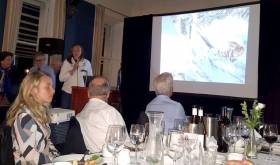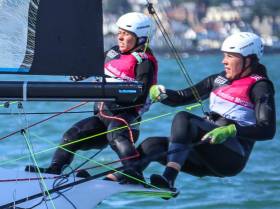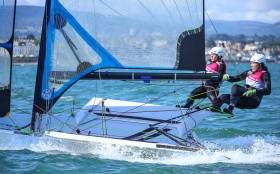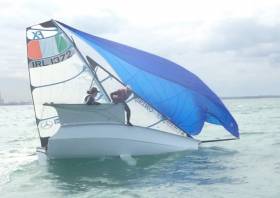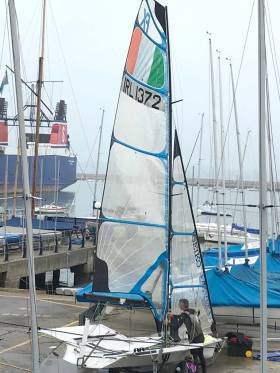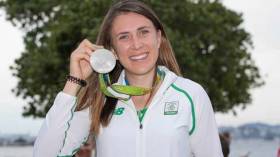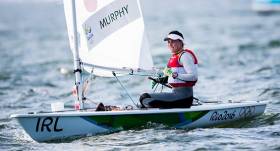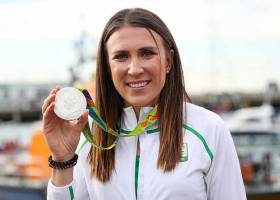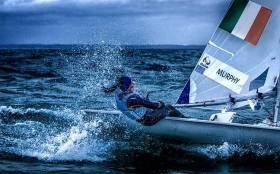Displaying items by tag: Annalise Murphy
Annalise Murphy Tells National Yacht Club Members About Volvo Ocean Race Experience
At last night's popular 'Speakers Supper' at the National Yacht Club in Dun Laoghaire, the club's own Olympic Silver Medalist Annalise Murphy gave a first-hand account of her personal experience and reflections in the Volvo Ocean Race that she completed in June.
The NYC superstar is now back into Olympic sailing mode having launched her new 49erFX campaign in a busy summer for the 28–year–old Dubliner. She is currently training on Dublin Bay most days from her base at the NYC.
This week in the Budget increased funding was announced for Olympic athletes. Hopefully, it is another boost before Tokyo 2020 so Annalise can realise her ambition to go one better and win Gold for Ireland in two years time.
Injury Setback for Annalise Murphy & Katie Tingle Olympic Sailing Campaign
Olympic Silver Medalist Annalise Murphy's bid for Tokyo 2020 glory has been set back with the injury news that her new sailing partner in the 49erFX dinghy campaign, Katie Tingle, suffered a broken arm during training.
Tingle, of Royal Cork Yacht Club, was brought ashore to the National Yacht Club in a RIB having suffered the fracture in training on Dublin Bay at the weekend.
NYC sailors attended to Tingle on the slipway and an ambulance was called to the East Pier club that is currently co-hosting the Laser Master World Championships.
A spokeswoman for the Olympic Sailing Team said Tingle 'broke her arm while she was out on the water' but no other update was available.
Murphy and Tingle, who did not travel to Japan with team–mates for the World Cup event on 2020 Olympic Waters, were instead due to sail this weekend at a 'Speed' event on Belfast Lough.
Annalise Murphy & Katie Tingle to Launch New 49erfx Campaign at Ballyholme's 'Weekend of Speed' Event
Annalise Murphy will launch her new Olympic sailing campaign in the 49erFx at Ballyholme Yacht Club's 'Weekend of Speed' on Saturday and Sunday, 15th and 16th September.
The Rio Olympic silver medalist will race under handicap against men's high-performance Olympic 49er teams as she and crew Katie Tingle are one of perhaps only two 49erFx's sailed in the country.
Ballyholme's Irish Open Multihull Championships incorporates the Irish F18 Championships and the Irish 49er Championships and a 29er event will also be held. According to organiser Richard Swanston, boats will be attending from 'across Ireland'.
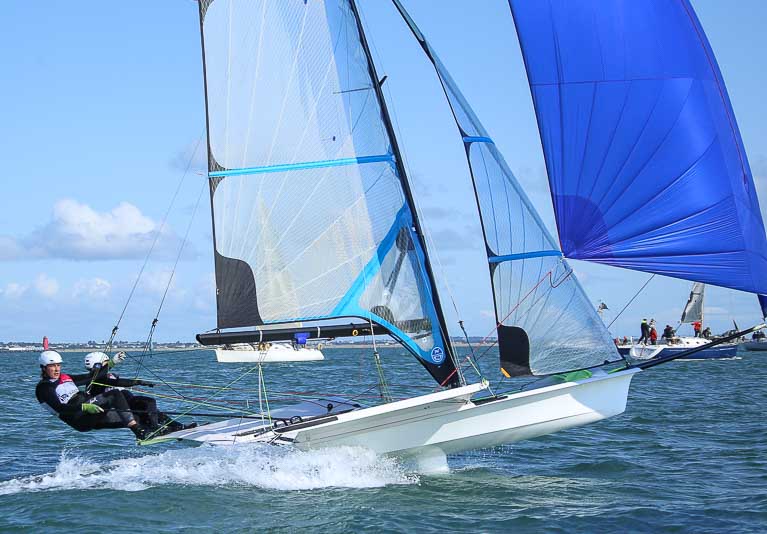 Annalise Murphy and Katie Tingle at speed on Dublin Bay in the 49er FX dinghy Photo: Afloat.ie
Annalise Murphy and Katie Tingle at speed on Dublin Bay in the 49er FX dinghy Photo: Afloat.ie
The four F18’s that attended the recent European Championships in Spain will test their skills against the best of the Irish fleet in an open championship. This fleet will include everything catamaran; Dart 16, Catapult, Hurricane 5.9 and F18s.
Murphy and Tingle, meanwhile, begin their trail to the Tokyo 2020 Olympics in their new 49er FX along with the 49er fleet which includes Olympians Matt McGovern and Ryan Seaton expecting to have their first competitive match since going separate their ways after Rio.
The 49ers are expecting eight boats for the Belfast Lough competition.
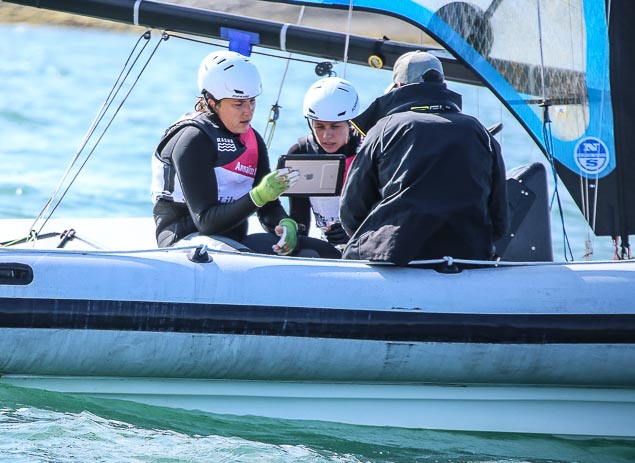 Annalise Murphy (left) and Katie Tingle review footage of a training run with coach Rory Fitzpatrick Photo: Afloat.ie
Annalise Murphy (left) and Katie Tingle review footage of a training run with coach Rory Fitzpatrick Photo: Afloat.ie
Currently, Murphy and Tingle are perfecting technique on their home waters of Dublin Bay where sometimes not everything goes to plan, even for Irish sailing's superstar.
The Ballyholme weekend will also feature seven to eight 29ers for a warm-up event for their National Championships.
If the weather is suitable the club will be running a speed challenge on the Friday evening, according to Swanston.
Annalise Murphy and Katie Tingle had a bit of a moment while training with their 49erFX on Dublin Bay earlier this week.
“We have everything under control here as you can see,” said Olympic Laser silver medallist Annalise as she shared the mishap on social media on Tuesday evening (17 July).
But capsizes are all part and parcel of getting to grips with a new sailing class, as fans and fellow sailors have commented.
As you can see we have everything under control here...? pic.twitter.com/89bhChCh0N
— Annalise Murphy (@Annalise_Murphy) July 17, 2018
And as the video below from the previous day shows, the new duo are already on to a promising start in their campaign for a Tokyo 2020 berth.
Olympic Silver medalist, Annalise Murphy may well be on board fifth placed 'Turn the Tide on Plastic' as the Volvo Ocean Race fleet hurtles towards the finish line in Cardiff but her recently announced Olympic 49er FX campaign is gaining momentum in her absence, as Afloat.ie's photo from the National Yacht Club reveals today.
Sporting the sail number IRL1372, Murphy's coach Rory Fitzpatrick was out on Dublin Bay in the 49erFX dinghy, training in anticipation of the return of the Rio superstar, now teamed up with Katie Tingle of Royal Cork in the double-handed women's class.
Murphy's full-on Tokyo 2020 campaign commences as soon as she gets free of VOR duties and it certainly looks like she wants to waste no time in ensuring her new campaign is up to speed.
The skiff is currently based at her NYC club but will shortly transfer to Irish Sailing's new 'Performance HQ' elsewhere in the harbour, where work started on a new floating dock last Friday.
Olympic Silver Medalist Annalise Murphy has quit the Laser Radial dinghy and launched a two–year campaign for the Tokyo Olympics in the 49er FX skiff dinghy.
The news is revealed in this morning's Irish Times Sailing Column here and it follows Murphy's two year hiatus from the class since Rio that had left everyone wondering, including team management, what the former European Radial Champion, would do next.
Ireland's most successful Olympic sailor, famously fourth in London and second in Rio, is currently competing in the Volvo Ocean Race as a crew member on Dee Caffari's Turn the Tide on Plastic, placed last in the seven boat fleet.
During this time Murphy (28) missed two important Radial World Championships, one through injury and more recently in April when she clarified why she would not attend this year's Danish Worlds in August, claiming she wanted more time following the end of the VOR to prepare for a 'return to the Radial'.
“If I was to go to Aarhus [Denmark] I wouldn’t have sailed the boat for almost a full year. I know how much work is needed to prepare for an event like that – I’m not stupid – you have to work hard and prepare, and I want to be winning events and in the hunt for medals rather than just making up the numbers.”
Regardless of her supreme achievements in the single–handed Radial spanning some 15–years, this short campaign will inevitably mean she will have to be content 'to be making up the numbers', at least at the beginning of the 49erFX bid, in a fleet where international competition in the class has been building steadily since Rio.
Murphy previously hinted at some switch when she said last month she was determined to complete her VOR commitment before deciding the 'best route' back to the Olympics.
Whichever way it is viewed, the switch is a big one for the National Yacht Club sailor who vowed to win Gold for Ireland during her homecoming celebrations in September 2016.
While details of the fledgling campaign are still scant, what is known is that Murphy must get up to competition speed in a new twin–trapezing skiff and negotiate sailing with a new partner as opposed to single–handed sailing; all this within a 24–month time–frame.
She intends to train every day with new team–mate Katie Tingle of Royal Cork Yacht Club, when the pair commence in July.
Murphy is not the only Dun Laoghaire sailor racing the 49erFX for Tokyo. She will be competing against former Rio team mate, Saskia Tidey who now sails for Team GB for 2020, on the circuit.
The 49er FX dinghy is a true high performance skiff, demanding athleticism, balance, skill and daring. The FX was developed to show to the world how spectacular sailing as a sport is and what 'amazing athletes' women sailors are.
Murphy's sister, Claudine was previously involved in a short–lived a Skiff for Rio in 2013.
Murphy now follows a path chosen by Brazilian Robert Scheidt, who has two Olympic gold Laser medals to his name, and who chose to campaign a mens 49er skiff for Tokyo, albeit late in his career. Sheidt was no stranger to sailing in Two Person fleets having taking Olympic silver and bronze medals in the Star, but the High Performance Skiff presented the 44–year–old champion with a different challenge that turned out to be short–lived one as he announced his retirement in 2017.
Much more in the Irish Times here
A pub row over Olympic sailing and Irish medallist Annalise Murphy ended with a baseball bat attack and a narrowly avoided jail sentence.
As Independent.ie reports, Dublin Circuit Criminal Court heard that Patrick O’Reilly struck Frank Shannon with the weapon after he was jeered for his support of “minority sports” at Tallaght’s Kiltipper Inn on 6 August 2016.
Defending barrister Gaby Dean BL told the court that her client “saw red” at the ridicule and left the pub to retrieve the bat, which which he assaulted Shannon.
Independent.ie has more on the story HERE.
Annalise Murphy & Company Convert Easterly Position Into Northerly Advantage In Volvo Ocean Race
#VOR - Dee Caffari’s Turn the Tide on Plastic saw their strategy pay off on Friday (27 April) as they regained the lead in Leg 8 of the Volvo Ocean Race.
Caffari’s crew – including Ireland's own Annalise Murphy – set themselves up as the most easterly boat as the seven-strong fleet climb up the coast of Brazil, bound for the finish in Newport, USA some 4,000 miles away.
Caffari and Turn the Tide on Plastic navigator Nico Lunven gambled that being furthest east would yield results, with better breeze giving them a boost on their rivals.
And as Leg 8 approached its sixth day, their tactics seemed to have paid off as they edged out a lead of more than 11 miles on former leg leaders Vestas 11th Hour Racing.
Despite their gains, it has been anything but plain sailing for Turn the Tide on Plastic as they try to dodge the huge South Atlantic clouds threatening to slow their progress north.
“We have reached the point where we can ease the sheets and sail faster, however the clouds have a different idea,” Caffari said.
“Last night we spent about eight hours under a cloud with the pressure changing all the time, the wind direction shifting all the time and it constantly raining.
“Endless sail changes relied on the crew being up for most of it and so there was very little sleep to be had. Even now we have cleared the monster clouds we have constant clouds rolling through.
“Some big some small, all with a wind pressure change, all with a slight wind shift and some with some precipitation. We have made a sail plan choice that allows us to make good progress when we are in real wind and able to adjust to the changes when we are facing yet another cloud.
“We now just need to keep trying to go fast in the right direction. Not always easy when yet another cloud is trying to make you wait for the others to overtake.”
Challenges aside, the mood onboard Turn the Tide on Plastic remains high.
“We’re leading right now which is fantastic,” Italian crew member Francesca Clapcich said. “We’re sailing a really solid leg – we just have to keep doing what we’re doing for another two weeks!”
The frontrunners aren’t the only ones suffering in the unstable weather brought about by the cloud activity.
With winds rocketing from less than 10 knots to 30 in a matter of minutes the chasing pack are just as susceptible to being caught out.
“There’s a lot of hot air where we are, and a lot of energy being created,” said Rob Greenhalgh, helmsman on sixth-placed MAPFRE. “These clouds pop up all over the place and they’re massive.
“Hopefully we’re through the worst of it now. The forecast for the next 48 hours is for lifting breeze and slightly faster angles.”
At 1300 UTC, MAPFRE were trailing Turn the Tide on Plastic by 48 miles but were the fastest boat in the fleet, making 16.2 knots.
“We’re in not too bad a shape but Turn the Tide are pushing forward and will continue to do so,” Greenhalgh added. “Hopefully things then change a bit and we can start getting back into them.”
Sun Hung Kai/Scallywag were today paying the price for being the most westerly boat, slipping to almost 50 miles behind the frontrunners.
The race tracker is currently live and will remain so for another 24 hours, allowing race fans to live out the battle for Leg 8 in real time.
Leg 8 Position Report, Friday 27 April (Day 6) at 4.20pm Irish time/3.20pm UTC:
- Turn The Tide on Plastic - DTF 4,003.7 nautical miles
- Vestas 11th Hour Racing +11.1 nautical miles
- Dongfeng Race Team +21.6
- Team Brunel +29.3
- Team AkzoNobel +30.5
- MAPFRE +49.8
- Sun Hung Kai/Scallywag +56.7
Annalise Murphy Expands on Decision Not to Contest World Championships & Says 'Olympic Ambition Remains'
Following the news that Annalise Murphy will not contest this year’s Sailing World Championships in the Laser Radial class, the Olympic Silver medallist has expanded on the reason behind her decision not to race in Denmark and confirmed her Olympic ambition for Tokyo 2020 Gold in this morning's Irish Times.
Earlier on Afloat.ie, Olympic Team Manager James O'Callaghan confirmed Aoife Hopkins as the automatic replacement for Murphy who is currently on Volvo Ocean Race duty with the Turn the Tide on Plastics Campaign.
O'Callaghan said that the National Yacht Club ace opted not to take the place as 'she decided she would not have enough time between finishing her VOR commitments and delivering a result she would be proud of'.
The Rathfarnham sailor points to the intensity of training needed to compete in a world championship. “If I was to go to Aarhus [Denmark] I wouldn’t have sailed the boat for almost a full year. I know how much work is needed to prepare for an event like that – I’m not stupid – you have to work hard and prepare, and I want to be winning events and in the hunt for medals rather than just making up the numbers.”
The Irish sailing superstar will be well aware that a host of new talent plus some of her arch international rivals for Tokyo 2020 Gold are already ratcheting up their Radial campaigns, including Rio gold medalist Marit Boumeester of Holland. For example, at last week's Trofeo Princesa Sofia Regatta, Denmark's Anne-Marie Rindom, Britain's Alison Young and Boumeester, all Rio competitors, were consistently placed in the top five of the World Cup regatta.
Murphy tells the newspaper that her 'Olympic ambition definitely remains, and all options to continue campaigning will be examined, but I’m determined to complete the Volvo Ocean Race commitment before deciding the best route'.
Read much more in the Irish Times here
Annalise Murphy Opts Out of World Sailing Championships
Ireland's Olympic Silver medalist Annalise Murphy (28) will not contest August's World Sailing Championships in Denmark where 40% of Tokyo Olympic places are up for grabs.
Howth Yacht Club's Aoife Hopkins (19) will now automatically be offered Ireland's first Laser Radial place at the Danish event in Aarhus.
According to the Olympic Team Manager James O'Callaghan, the National Yacht Club ace has opted not to take the place as she decided she would not have enough time between finishing her Volvo Ocean Race (VOR) commitments and delivering 'a result she would be proud of'.
Last August, Murphy put her Tokyo plans on hold with the original intention of making the 2018 World Championships following the conclusion of the Volvo Ocean Race in June.
Murphy withdrew from the 2017 Radial World championships citing a knee injury sustained while sailing in Italy. She also withdrew from the Test Event in Aarhus in 2017 as a result of the same injury.
The Irish team for Aarhus is Finn Lynch in the Laser Standard, Hopkins in the Radial, and Ryan Seaton and Seafra Guilfoyle in the 49er. O'Callaghan expects Ireland could secure at least two Tokyo berths.
Subsequent to World Sailing's original allocation of nation places, Ireland applied for and has received extra places based on World Ranking points. Three further 49er skiff places have been granted and now there are places too both for Aisling Keller and Liam Glynn in the Laser classes.
Details of Ireland's Tokyo 2020 prospects are discussed in an Afloat.ie podcast with the team manager here.


























